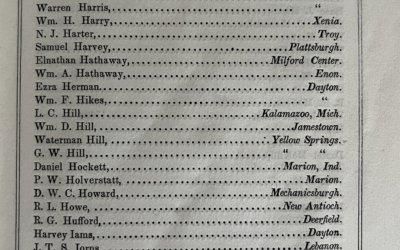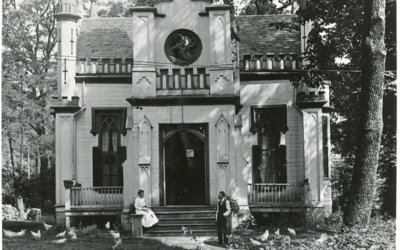After receiving a pair of haranguing entreaties from his mother Mary and his brother George to pack up his expedition to Hawaii and come home to Boston, Horace Mann Jr. received the following account of his youngest brother Benjamin’s trip up the Labrador coast. Born in 1848, Benji clearly shared his brother’s scientific bent (especially his interest in biology), and would go on to a career in entomology with the USDA. A founding member of the Cambridge Entomological Club (est. 1874) and editor of its journal Psyche (still in print today), he was also a bibliographer by nature, a talent reflected in the way Antiochiana’s Benjamin Pickman Mann collection is organized.
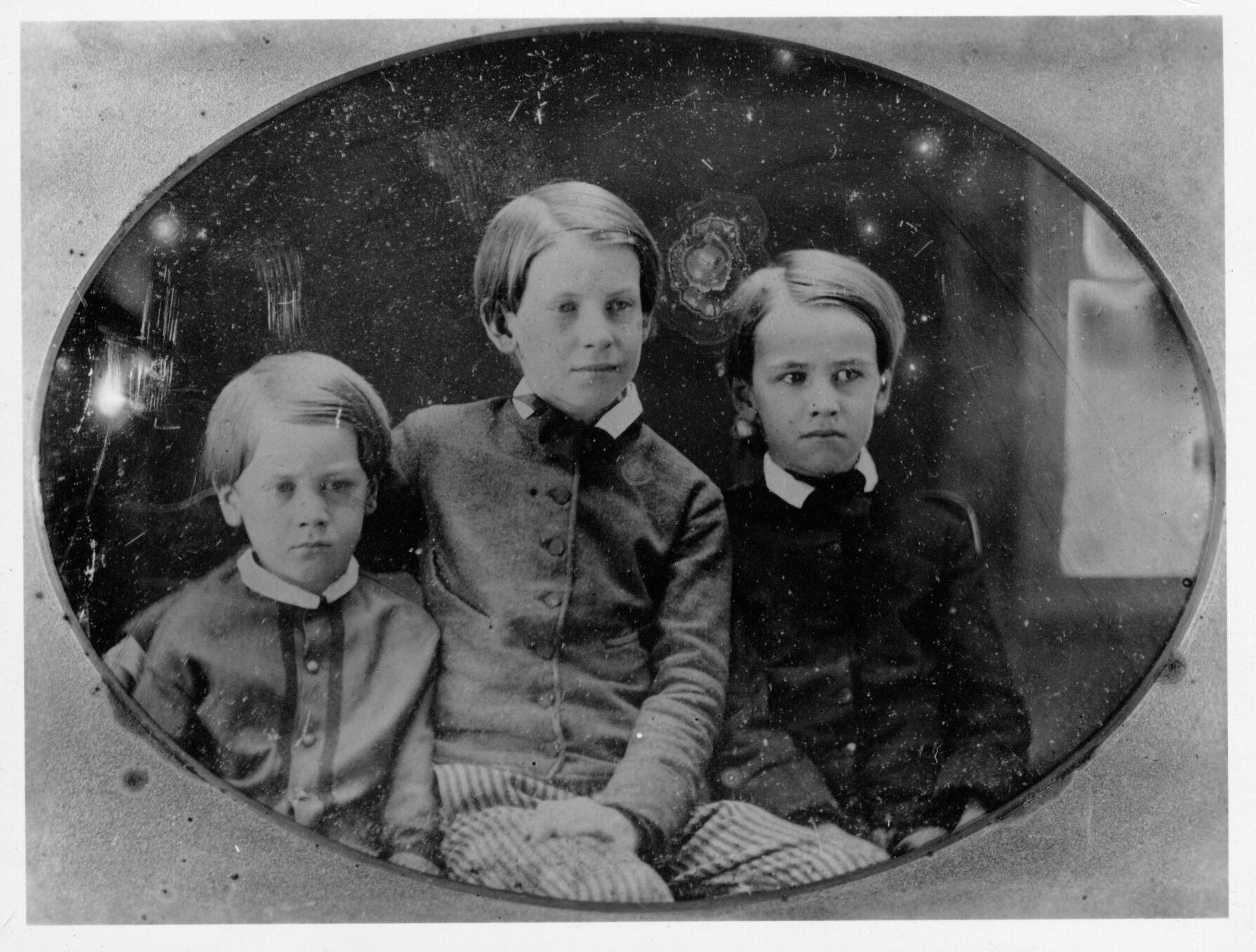
The sons of Horace and Mary Mann, c1855. Left to Right: Benjamin Pickman Mann, Horace Mann Jr., George Combe Mann.
Eager to get to the copious details of his journey, Benji brushes Lincoln’s imminent reelection aside, unlike the letters by Mary and George. He’s so excited to tell Horace Jr. of his travels, in fact, he relates them in one massive paragraph of over 2000 words, broken only by a few hand drawn diagrams (omitted here for layout purposes but noted in brackets). Though he cannot know it, Benji dramatically illustrates to 21st-century eyes how much science has changed since his time.
He’s sailed to the Canadian provinces of Labrador and Newfoundland on an Oological expedition to collect birds eggs. Then a legitimate science, but now long-since outlawed, without the benefit of modern binoculars, oologists found it extremely difficult to study birds in the wild and resorted to taking their eggs for study. His account of “egging” for auks or alcids (such as the murre and the puffin) unknowingly explain how the largest of the species, Pinguinus impennis, known as the Great Auk, could be hunted to extinction by the mid 1840s. He later collects bones from an Inuit grave, again for scientific purposes, dismissing the objections of local fishermen (presumably Inuit themselves) as superstition.
Found amid the meticulous descriptions of his surroundings are Benji’s encounters with the local population, the colonialism of the time on full display. For example, he meets a missionary (undoubtedly there to convert Inuit to Christianity) and characterizes the “Esquimaux” as under the man’s care. The Acadians he speaks of that “talk a corrupted French” are a unique culture, descendants of 17th-century French settlers and indigenous populations, and the “adverse conditions” that drove them from homes in Nova Scotia occurred during the British conquest of Canada in the French and Indian War and The Great Expulsion that came with it.
Concord, Mass., U.S.A., Nov. 7, 1864
Dear Horace
There is no doubt regarding the elections tomorrow. Hon. Mr. Whiting gave us a speech in the Town Hall on Saturday night, and it is said that he converted many to Lincolnism. I know for my part that he converted Dennis O’Keefe, who is still perseveringly going to school. I got your letter of Sept. 8 on Saturday (5) of this month, and so I am going to try to do what you wanted. I was very glad to hear the advice you put in, and read the letter over many times. There was a dance in the Town Hall Saturday p.m., which I attended. The first harbor we touched on in Labrador was Sloop Harbor, among the Goose (?) Islands. On going ashore, we ran into a snowbank of some hundreds of feet in extent, but not very deep. The island was perhaps 200 feet high, the slopes being rather gradual, and on the top was a small lake, such as we sometimes find in our meadows where turf has been dug out. The island was pretty large, and on the further side of it was a settlement of people who formerly came from Canada, but have lived here a long time. These talk a corrupted French, and are people who were once in good circumstances, but were driven from home by adverse circumstances. The island is rocky, something like the summit of the “Cliffs” at home, with slumpy moss, and many crawling birch (?) trees. There are about a hundred islands, some more rocky, some entirely rocks, not all as high as this. There are a few cliffs, and some places on the islands appear as richly soiled as some of our meadows at home. The Eider Ducks breed on the islands in proportion to the pond-area they contain, I having collected 70 or 80 eggs in a place of 20 feet by 10 under bushes of two feet high, and near a pond. I might have got bushels of Eider Down, which would have sold, if I pleased to dispose of it thus, for a large amount, but I had all my room filled with eggs, as heavy a bundle as I could carry, and had to throw all my down away! The Gulls breed on the side of steep hills, on a ledge, or sometimes make a round and shallow nest on a level piece, at the foot of a hill or terrace. The Cormorants breed on the ledges of high overhanging cliffs, where a man must be lowered to obtain them. Mr. Bradford got about 40 eggs, but no more, as he was afraid the man would fall! How he could fall at all remains in doubt to me. The Auks breed in vast numbers on high rocky islands, in crevices under the rocks as far as they can squeeze in stern first, and leave the eggs to sit on themselves. The Murres do not breed on these islands much, if any, but on Treble(?) Island, which we touched after leaving here, and on Murre Rocks wh. we passed before arriving here, and on Tinker Island, to be mentioned hereafter, and on various other detached islands, the Murre is the order of the day. Again on low islands, with easy ground, the Ruffins burrow a perfect network, so that you can walk nowhere without slumping. We remained in this harbor 5 days, occasionally seeing whales of different kinds, amongst others one white whale. The whole S.E. part of Labrador is far north on the coast as L’Ance a Loup belongs to Canada, beyond this as far as Cape Harrison to Newfoundland, and the Moravian missionaries appear to have the rest of the eastern coast. But more of these as I arrive at them. Treble Island, where we stood off and on for a while, and went ashore, is a high island of solid rock till you arrive on the tip top, but it is very rough, all piled in every imaginable form leaving cracks and crevices everywhere, which the Murres fill with eggs. The eggers going into these islands break all the eggs they find, and next day a supply of fresh eggs is laid. They take these, and kill all the birds they can hit with their sticks, and they sometimes get a great many. From here we progressed till we arrived at Salmon Bay. Here is a missionary who preaches weekly to the fishermen for 5 or 10 miles along the coast. There is a building there where the missionary, his wife and child live, and in which ia the chapel, a room about 1/2 the size of our Unitarian Vestry, low, but useful for the purpose. The vestry at Wayland forcibly reminded me of it. This island (Caribou) is a low island with hills of 70 or 80 feet on each end, and marshy in some places; but in winter the missionary and his Esquimaux, for I believe he has a few under his care, remove up Salmon River about 9 miles to Winter Habitations. The missionary is a very pleasant man, an American, employed by a British society, C.C. Carpenter by name. We stayed here over Sunday, and our Episcopal minister, we had Mr. Wesson also, preached, but I did not consider it worth attending, although afterwards I found that he preached pretty well. On the 21st of June, the day after we left Salmon Bay, we ran into the ice lumps, small pieces of ice, none or few of which exceeded 20 feet in length. We spent a part of our day amongst these, but a high wind came up in the night, and on awaking the next morning, we found ourselves in Belles Amours Harbor. This harbor was nothing more than a bight, or piece of water running inland around a curve, thus, with a little island in the middle, covered at high tide. Here the hills were 300 or 400 feet high, and some cliffs of about the same height, but not extending all round the harbor. There is a large lake in the interior, from which a river equal to our streams of size runs into the sea. Here I obtained among the thickets the first Black Foil warbler I had ever seen, and came to appreciate in modo if not in re what pine forests were on the White Mountains. We remained in this harbor four days, and I got the head of a grampus, which was lying around loose, and which I intended to bring home for the Museum; but either by accident or design it got overboard about a week after. On the 26th of June we entered Henley Harbor in Chateau Bay, which I shall describe from a composition I have written on the subject. This harbor is in the Straits of Belle Isle, near Cape Charles, and is composed of three islands placed somewhat thus: [illustration] As I am not a very good describer, I shall quote a description from Harper’s Monthly: “This castle (V. fig.) is a most remarkable piece of basaltic rock, rising in vertical columns from an insulated bed of granite. Its height from the level of the ocean is upwards of 200 feet. It is composed of regular 5-sided prisms, and on all sides the ground is strown with single blocks and clusters that have become detached, and fallen from their places. The reef is another massive pile of similar formation and separated from its counterpart by a deep and narrow channel.” The top of the “castle” is a level table land of about an acre in extent, and is only accessible by a difficult climb on one end. From this may be obtained a sweeping view of the Straits of Belle Isle, in which were some ice bergs when we arrived. The northern side of the island was first broken by overhanging cliffs fully a hundred feet high, and then prolonged out into a gradually sloping beach, in some places formed of stones and pebbles, in others of solid and worn rock. A wooden cross is placed on the highest point of the island. The other end is low and marshy, and the soil is not very rich. It appears as if this island was formerly joined to the “reef”, but became separated by some convulsion of nature. On the third island lives Capt. Kennedy, the principal man here, who fishes and trades, mostly the latter. Near his house, where you see a hill in the picture is an Esquimaux burial ground which was first discovered, a week before we arrived in the harbor, while returning, by a storm having washed away the surface of the island. Here Packard got an upper and an under jaw, which I think without exaggeration were 6 inches wide, perhaps more. I got the top of a skull, which is in about the same proportion, showing large development. Some of the fishermen were rather superstitious, and objected to our turning up the graves, but they made no interference. Near the harbor, on the main-land, is Fort Pitt, built before the revolution, where the Acadians went after being driven from Nova Scotia. We had a little Curlew shooting near this fort, but it was too early in the season. On the first of July we left Henley Harbor, but head winds, that bother that had thwarted us before, made us run into Square Island Harbor, some twenty miles distant. Our avowed intention, expressed on that afternoon, was that we would stay over night, and work on ahead the next day. The result was that we stayed in harbor 15 days! Cause, the ice came in the night of the 1rst, and stayed in! It was so thick that we could and did walk ashore. I got in once. Here we passed the 4th of July. Mr. Ham gave an oration, salutes were fired, songs were sung, &c. One of the Nfdld. vessels in harbor answered our salute with a cannon, and we had a gay time. Here various poems were composed, amongst others one of wh. I was the subject. I have copies, but they will occupy too much room, and you are sufficiently interested, they will be in existence when you come home. Square Island contains some hundreds of acres, perhaps a thousand, or more. It contains a half dozen or a dozen lakes, all of considerable size, & some brooks, mountain (?) streams. There are about 20 or 30 cabins along shore, in wh. the fishermen live. These fishermen come to the coast in May or June, and fish for cod, herring & salmon. The people range from low to middle class, some being quite respectable people. The island is mostly rock along shore, but inland fertile, with pines and birches, making progress somewhat difficult. The Harbor is somewhat thus: (Come to think of it, Square Island is the little island you see represented, and the one I described is another island.) We saw as much floe ice as we wanted. From here we ran to Dominoe, a small harbor thus: in the Island of Ponds. Nearly half the island is pond-water, & the rest hilly. A Mr. Duff lives here, a frank, free, and hospitable Englishman, who has the use of the place if he does not own it. We all went in to his house, and conversed with his wife and daughters. The people here, some of them, are more intelligent than you would suppose. In Belles Amours, mentioned before, we found a young lady, learned in the French language, and conversant with the best works of our greatest writers. The islands along here are all much alike, and we run for a hundred miles amongst them. Our vessel was the finest of its kind in the United States, a regular clipper, and we saw vessels but to pass them. This run, which was a pretty straight line, was a fine place to exhibit our sailing qualities. After running about a half day, we again dropped into Dumpling Harbor in Sandwich Bay. The mainland here runs up into high hills 250 to 300 feet high, and magnificent. About 100 rods or perhaps yards from the mainland is a low island. Behind this island we make the harbor thus: [illustration] On this island are the remains of a large brick building, which was formerly a fishing station, now destroyed. Near this also some graves made as deep as possible, two feet, and then heaped up, and surrounded with a rude fence. On this island I caught Ohionobas Semidea, which appeared (July 17th) as if just hatched. I also found Menyanthes trifolia, rather old, and many flowers of the Baked Apple, with petals falling or fallen. That night we entered Tub Harbor, which looks like a soldier cap: [illustration] (The preceding is a bull. The Island looks like a cap.) The harbor is thus: with plenty of reefs strewed around promiscuously. The place is Lat. 54° 121, Long. 56° 40’.
Here I discontinue, but will write again.
Your loving brother
Benj. P. Mann
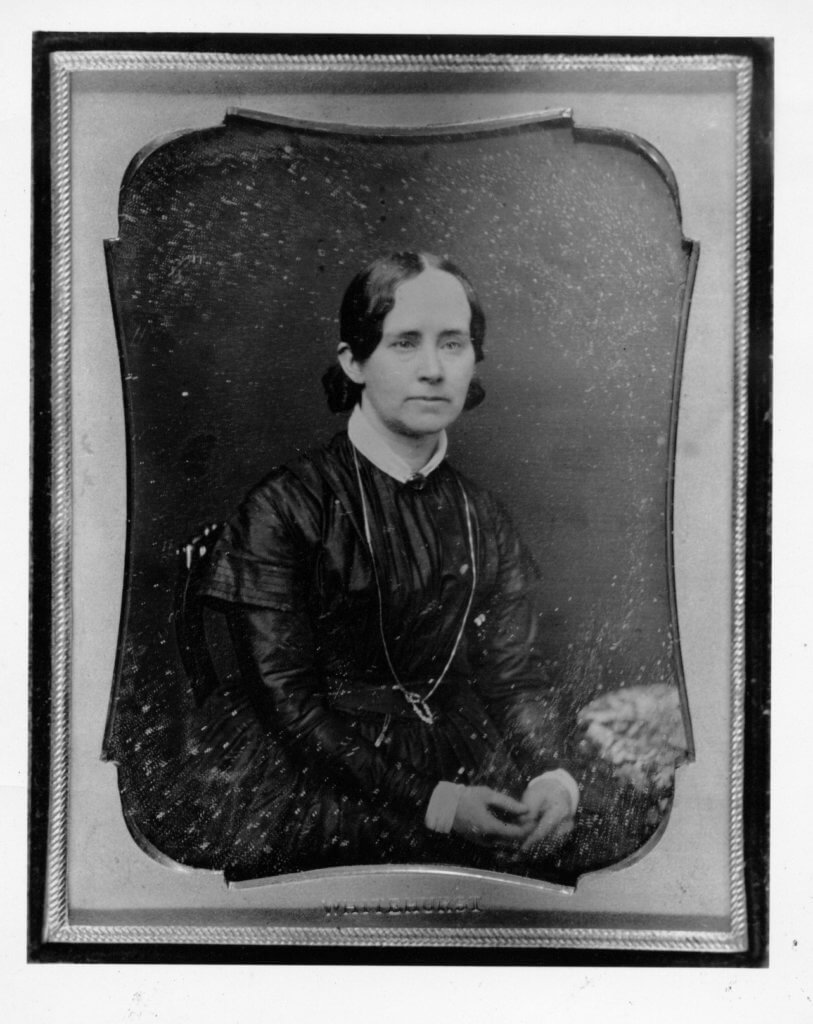
Mary Mann
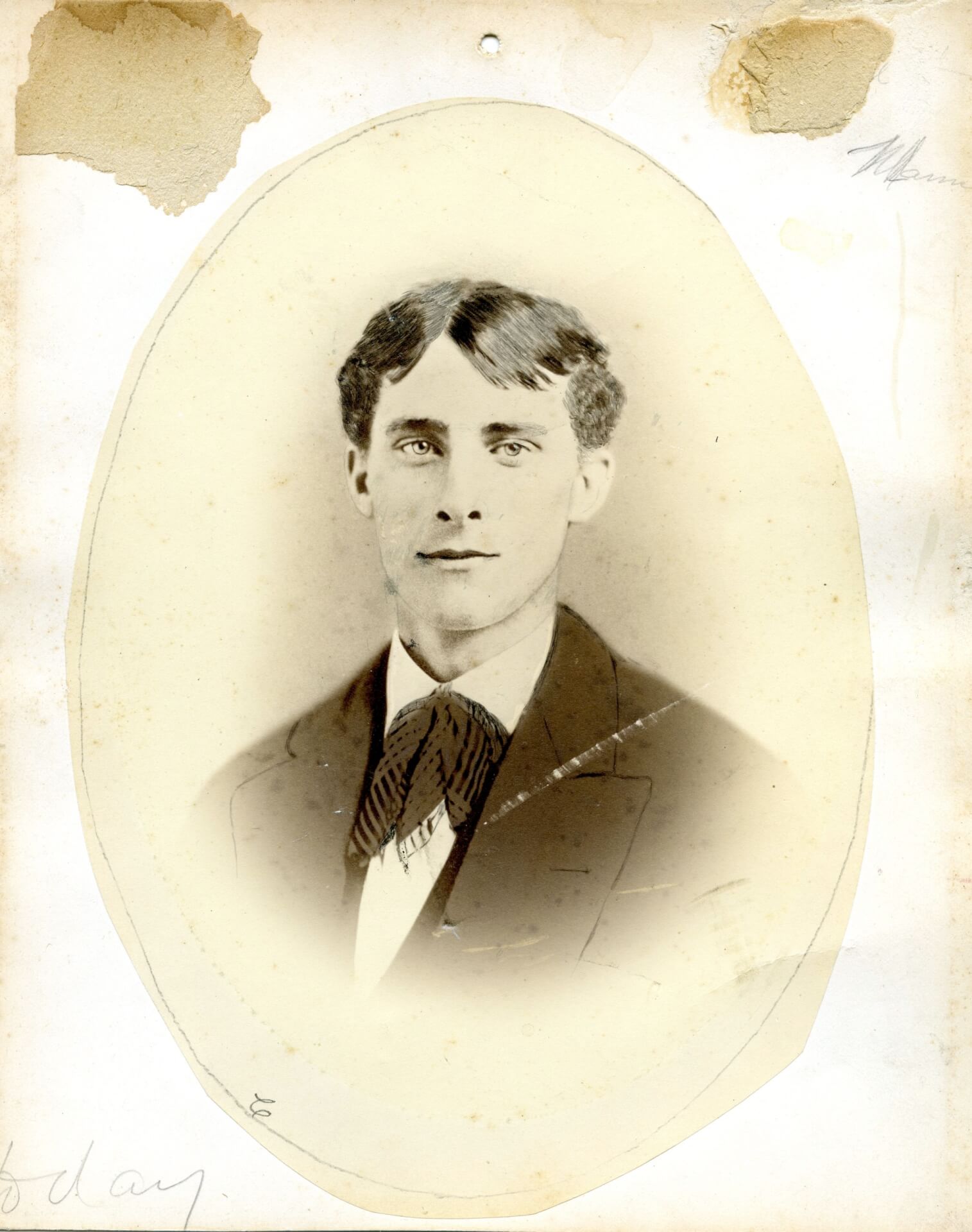
Horace Mann Jr.
“Songs From the Stacks” is a regular selection from Antiochiana: the Antioch College archives by College Archivist Scott Sanders.


